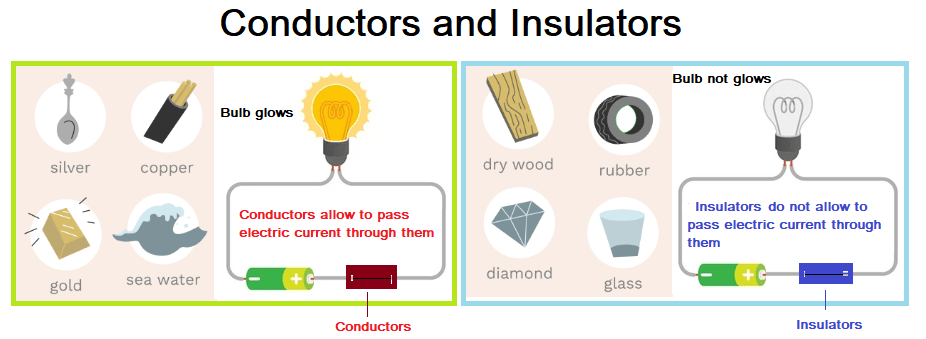Conductors and insulators important facts
Conductors are materials that allow electricity to flow through them, while insulators are materials that resist the flow of electricity. These materials have free electrons that can easily move throughout the material, which allows electricity to flow through them easily.
Some common conductors include metals such as copper, aluminum, gold, and silver.
On the other hand, insulators are materials that do not conduct electricity well. These materials have tightly bound electrons, which means they don’t have free electrons that can move throughout the material to allow the flow of electricity.
Some common insulators include rubber, glass, plastic, and air.
It’s important to note that some materials can act as both conductors and insulators, depending on the circumstances. For example, air is typically an insulator, but it can become a conductor if it becomes ionized (i.e., has an electric charge).
Table of Contents
Difference between Conductors and insulators:
| Conductors | Insulators |
|---|---|
| Conductors are materials that allow electricity to flow through them. | Insulators are materials that resist the flow of electricity. |
| Cause: These materials have free electrons that can easily move throughout the material and participate in conductivity. | These materials do not have free electrons to participate in conductivity. |
| These materials have very high conductivity and small resistivity. | These materials have low conductivity and very high resistivity. |
| Conductivity (σ) = 102 to 108 Sm-1 | σ = 10-11 to 10-19 Sm-1 |
| Resistivity (ρ) = 10-2 to 10-8Ωm | ρ = 1011 to 1019 Ωm |
| Example : Copper, aluminum, gold, and silver etc. | Example: rubber, glass, plastic, and air etc. |

Cause of conductivity:
The ability of a material to conduct or insulate electric current is determined by the nature of its atoms and the arrangement of its electrons. Materials with loosely bound electrons, such as metals, make good conductors because their electrons can easily move from atom to another atom. On the other hand, insulators have tightly bound electrons that do not move easily, which makes it difficult for electric current to flow through them.
Important questions from Topic
What are conductors and insulators?
Answer: Conductors are materials that allow electric current to pass through them easily, while insulators are materials that resist the flow of electric current.
Why are metals good conductors of electricity?
A: Metals are good conductors of electricity due to their low resistance to electrical current, which allows electrons to flow easily through them.
What are some examples of conductors?
A: Common examples of conductors include copper wires used in electrical wiring, aluminum foil used in cooking, and steel bars used in construction.
What are some examples of insulators?
A: Insulators include rubber coatings on wires, plastic casing on electrical devices, glass, and porcelain.
What determines whether a material is a conductor or an insulator?
Answer: The ability of a material to conduct or insulate electric current is determined by the nature of its atoms and the avaliability of free electrons to participate in conductivity..
Are conductors also good thermal conductors?
A: Yes, conductors are also good thermal conductors, meaning they allow heat to flow through them easily.
What are some common applications of conductors and insulators?
A: Conductors are commonly used in electrical wiring, while insulators are used in electrical insulation and protective coatings.
What is the relationship between conductivity and resistivity?
A: Conductivity and resistivity are inversely related. A material with high conductivity has low resistivity, while a material with low conductivity has high resistivity.
How does temperature affect conductivity?
A: Temperature can affect conductivity in different ways depending on the material. In metals, for example, increasing temperature usually increases resistance, which in turn decreases conductivity. In some semiconductors, however, increasing temperature can increase conductivity.
What is the difference between a semiconductor and a conductor?
A: Semiconductors are materials that have intermediate conductivity, meaning they are neither good conductors nor good insulators. They have a narrow band gap between the valence and conduction bands, which allows them to conduct electricity under certain conditions. Conductors, on the other hand, have high conductivity and low resistivity, which allows them to conduct electricity easily.
How does doping affect the conductivity of semiconductors?
A: Doping is the process of intentionally adding impurities to a semiconductor to modify its electrical properties. Doping can increase or decrease the conductivity of a semiconductor depending on the type of impurities added and their concentration.
How do insulators protect against electrical shocks?
A: Insulators protect against electrical shocks by preventing the flow of electric current through them. They are often used as coatings on wires and electrical devices to prevent accidental contact with live circuits.
What is dielectric breakdown and how does it relate to insulators?
A: Dielectric breakdown is the process by which an insulator fails and allows electric current to flow through it. This can occur when the electric field within the insulator becomes too strong, causing electrons to be stripped from atoms and creating a conductive path. The ability of an insulator to withstand dielectric breakdown is an important consideration in electrical engineering and circuit design.
Activities Supporting Speaking Skill Development
Conductors and insulators important facts